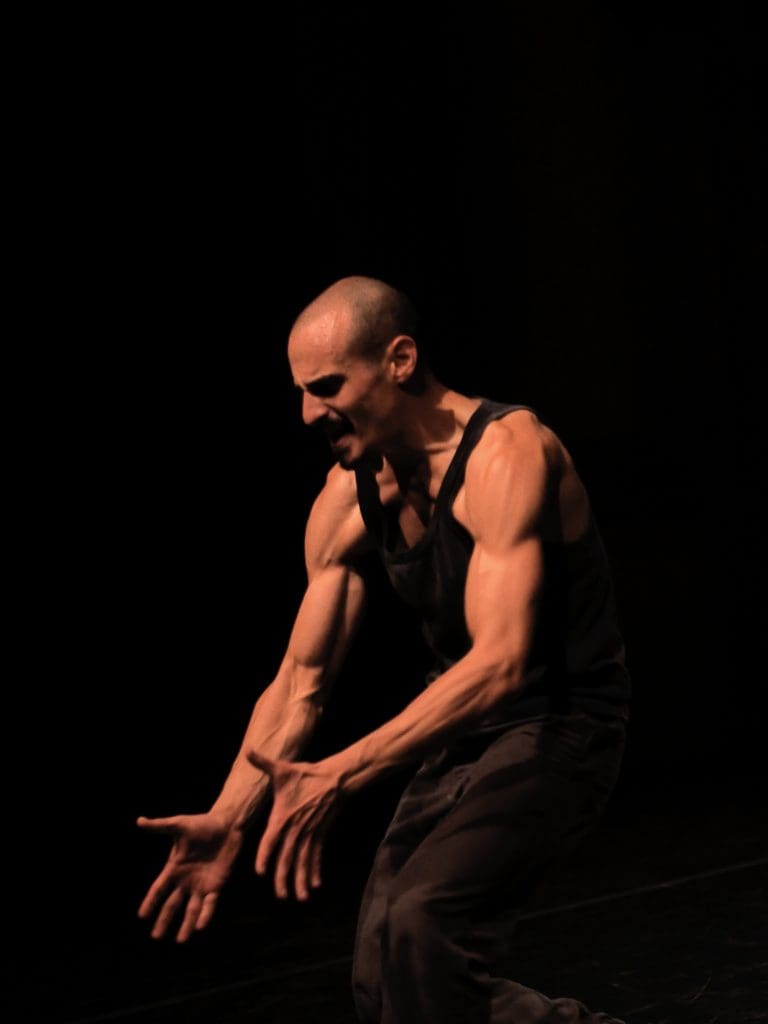Michael Getman’s choreography: ‘First Things’, performed by Ariel Gilbert on Yerushalmi’s compact stage, turned out to be intriguing, powerful, and contained distinct original elements.
The work aims to explore the body in new ways. Getman begins by treating it as separated exposed segments while revealing undefined fragments of the dancer’s body. The use of a contained approach for the stage’s lighting design on one hand and a particular sense of timing on the other gives power to the dance. Thus, lighting designer Nadav Barnea becomes the third creative partner of the performance. As a result, the opening chapter carries a strong artistic mark.

The work is composed of three rather distinct layers. Getman kept tight control of the pace of its progression aiming to built-up tension by restraining information concerning the semi-hidden dancer that kept the viewers in a deep dark. Literally.
Curled on the floor Gelbert slowly changed positions yet he remained confined to one square meter. Occasionally he raised an arm or positioned himself so we could see a fleeting glimpse of his partially exposed skin, a fraction of his back, a foot. It took a very long time before the elusive Gelbert wobbled up and stood on his feet. The human body that we now saw seemed distressed. Lost in his own limbo while his deconstructed, sporadic motions offered him no miraculous salvation. Most of the time, there was minimal use of sounds; far away big birds chirped and later, for a moment, the edgy moves were soothed by a Beethoven sonata playing in the background.
On pauses between the scenes, he put on a pair of trousers and settled on a vacant seat on the first row, breaking away from the illusions he worked so hard to create on stage. A clash between matter and form became clearer as time passed and the dancer covered a broader space, yet retained the fragmented style of the body’s actions as he gradually dared to open up.
Since the work wasn’t leaning on a clear narrative, it was difficult to predict where the next choreographed scene will take us.
The earlier abstract images gave way to a process that led toward more concrete statements about the human body and its actual appearance. The latter part gave Gelbert room to open his wings and move freely, partially improvising. His movement became the music. His body revealed unsuspected inner powers and followed rhythms that pushed him up.
Getman had already proved that he could build solo works for exceptional dancers, as he tailored before to an Israeli dancer and exquisite international star- Talia Paz. Offering the role of this solo work to Arial Gelbert was clever move, since he is really a fine dancer with a strong stage presence. Shifting from relying on nuances and minimal gestures to powerful, highly intense, almost violent ones, enabled him to cover the gap between the sporadic exposure at the beginning to an abundance of fast, endless whirling steps which ended in total immersion of contradicting elements inside the dancing human body.
It was a pleasure to see the refined choreography by Michael Getman and the fine interpretation by Gilbert who totally commanded the stage.